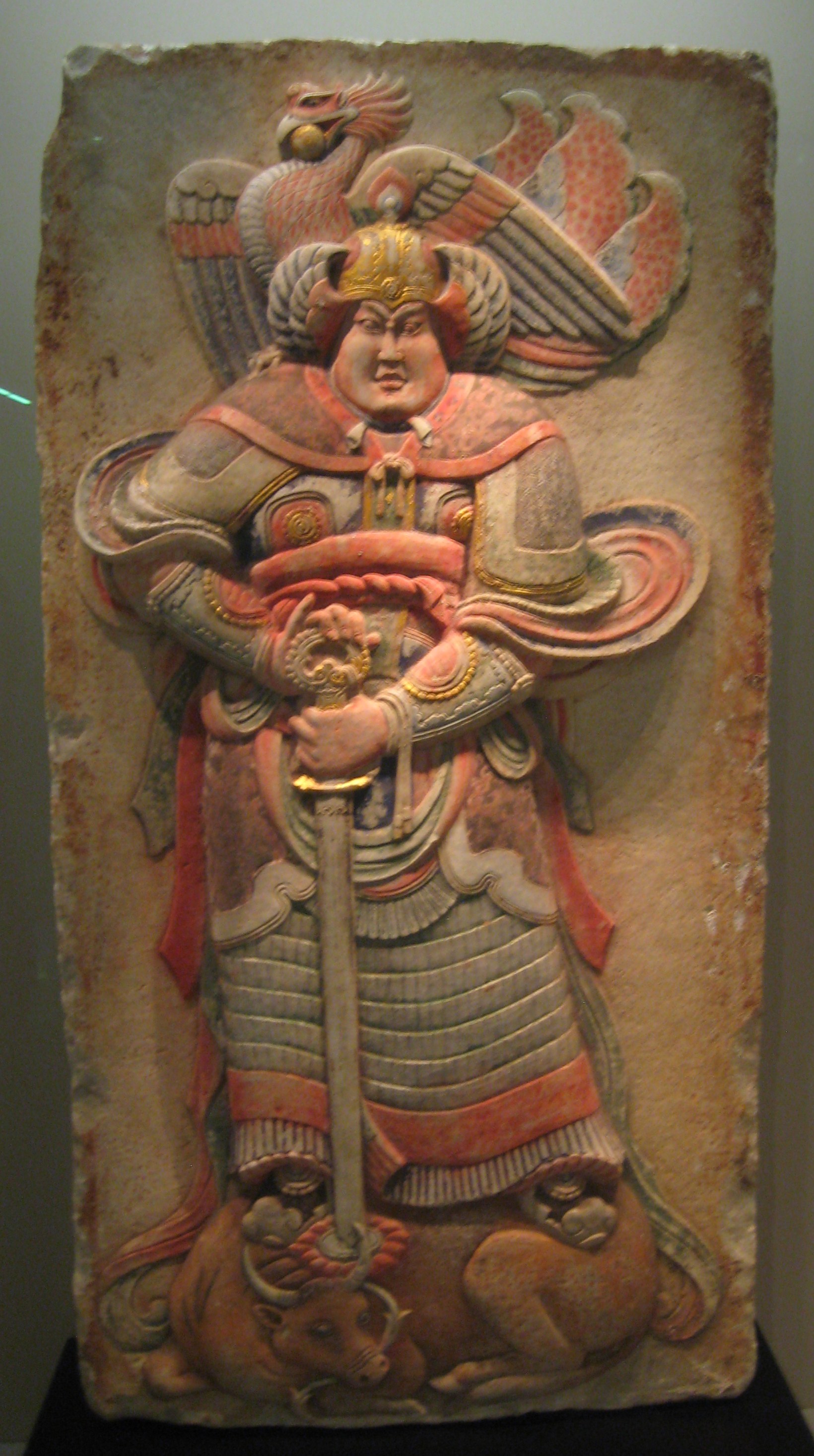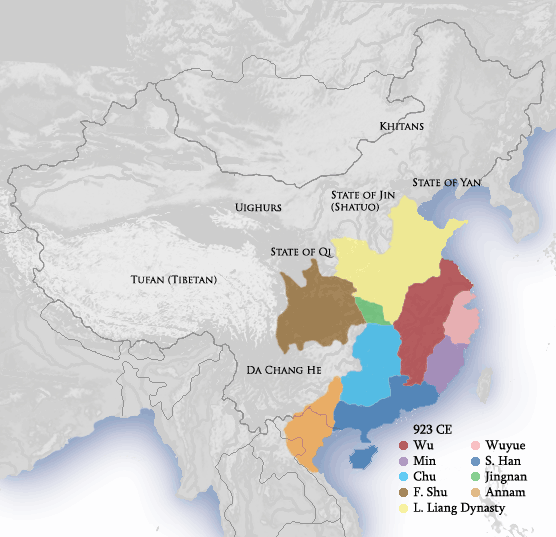|
Zhao Ying
Zhao Ying (; 885 – June 8, 951''Old History of the Five Dynasties'', :zh:s:舊五代史/卷89, vol. 89.''Zizhi Tongjian'', :zh:s:資治通鑑/卷290, vol. 290.), courtesy name Yuanhui (), was a Chinese historian, military general, and politician of the History of China, Chinese Five Dynasties and Ten Kingdoms period Later Tang and Later Jin (Five Dynasties), Later Jin states, serving as a Chancellor of the Tang dynasty, chancellor during Later Jin. Background Zhao Ying was born in 885, during the reign of Emperor Xizong of Tang. His family was from Huayin (華陰, in modern Weinan, Shaanxi). His great-grandfather Zhao Pu () and grandfather Zhao Ru () each had minor official careers — Zhao Pu reached the office of county secretary general, albeit of a major county (Jiangdu (江都, in modern Yangzhou, Jiangsu)) and Zhao Ru reached the office of ''Zhengzi'' (), an assistant copyeditor at the Palace Library. Zhao Ying's father Zhao Juhui () was a farmer, probably at the ancestra ... [...More Info...] [...Related Items...] OR: [Wikipedia] [Google] [Baidu] |
Old History Of The Five Dynasties
The ''Old History of the Five Dynasties'' ( zh, t=舊五代史, pinyin=, p=Jiù Wǔdài Shǐ) was an official history mainly focusing on Five Dynasties and Ten Kingdoms period, Five Dynasties era (907–960), which controlled much of northern China proper, China. And it also includes some history of other south states during the era. It was compiled by the Song dynasty official-scholar Xue Juzheng in the first two decades of the Song dynasty, which was founded in 960. It is one of the Twenty-Four Histories recognized through Chinese history. The book comprises 150 chapters, and was in effect divided into 7 books, they are: ''Book of Liang'' (24 volume), ''Book of Tang'' (50 volume), ''Book of Jin'' (24 volume), ''Book of Han'' (11 volume), ''Book of Zhou'' (22 volume), ''Biography, Liezhuan'' (7 volume) and ''Zhi'' (12 volume), respectively''.'' After the ''New History of the Five Dynasties'' by Ouyang Xiu was published, it was no longer popular. In the 12th century it was remov ... [...More Info...] [...Related Items...] OR: [Wikipedia] [Google] [Baidu] |
Later Liang (Five Dynasties)
Liang, known in historiography as the Later Liang () (1 June 907 – 19 November 923) or the Zhu Liang (), was an imperial dynasty of China and the first of the Five Dynasties during the Five Dynasties and Ten Kingdoms period. It was founded by Zhu Wen (Emperor Taizu), after he forced the last emperor of the Tang dynasty to abdicate in his favour (and then murdered him). The Later Liang would last until 923 when it was destroyed by the Later Tang dynasty. Formation Zhu Wen initially allied himself as Huang Chao's lieutenant. However, he took Huang's best troops and established his own power base as a warlord in Kaifeng. By 904, he had exerted control over both of the twin Tang dynasty capitals of Chang'an and Luoyang. Tang emperor Zhaozong was ordered murdered by Zhu in 904 and the last Tang emperor, Ai Di ( Emperor Ai of Tang), was deposed three years later. Emperor Ai of Tang was murdered in 908, also ordered by Zhu. Meanwhile, Zhu Wen declared himself emperor of ... [...More Info...] [...Related Items...] OR: [Wikipedia] [Google] [Baidu] |
Taiyuan
Taiyuan; Mandarin pronunciation: (Jin Chinese, Taiyuan Jin: /tʰai˦˥ ye˩˩/) is the capital of Shanxi, China. Taiyuan is the political, economic, cultural and international exchange center of Shanxi Province. It is an industrial base focusing on energy and heavy chemicals. Throughout its long history, Taiyuan was the capital or provisional capital of many dynasties in China, hence the name ( zh, s=龙城, p=Dragon City, labels=no). As of 2021, the city governs 6 districts, 3 counties, and hosts a county-level city with a total area of 6,988 square kilometers and a permanent population of 5,390,957. Taiyuan is located roughly in the centre of Shanxi, with the Fen River flowing through the central city. Etymology and names The two Chinese characters of the city's name are (, "great") and (, "plain"), referring to the location where the Fen River leaves the mountains and enters a relatively flat plain. Throughout its long history, the city had various names, including ... [...More Info...] [...Related Items...] OR: [Wikipedia] [Google] [Baidu] |
Shi Jingtang
Shi Jingtang ( zh, 石敬瑭; 30 March 892 – 28 July 942''Zizhi Tongjian'', vol. 283.), also known by his temple name as the Emperor Gaozu of Later Jin (), was the founding emperor of the Later Jin dynasty of China during the Five Dynasties and Ten Kingdoms period, reigning from 936 until his death. Shi was an ethnic Shatuo and was an important military general for the Later Tang before rebelling in 936. He enlisted the help of the Khitan-led Liao dynasty in his struggle against the Later Tang dynasty. For this he was called Emperor Taizong of Liao's adopted son (even though he was 10 years older). After Shi's rise to power, the Liao would later annex the strategically crucial Sixteen Prefectures and eventually annex the entire Later Jin. The rise of the Liao in northern China and the Mongolian Plateau would shape Chinese politics for the centuries leading up to the Mongol Empire. Background and early life The official history '' Old History of the Five Dynastie ... [...More Info...] [...Related Items...] OR: [Wikipedia] [Google] [Baidu] |
Li Siyuan
Li Siyuan (李嗣源, later changed to Li Dan (李亶)) (10 October 867 – 15 December 933), also known by his temple name as the Emperor Mingzong of Later Tang (後唐明宗), was the second emperor of the Later Tang dynasty of China, reigning from 926 until his death. He was an ethnic Shatuo originally named, in the Shatuo language, Miaojilie (邈佶烈). Adopted by the ethnic Shatuo ruler Li Keyong of the Former Jin dynasty, Li Siyuan became a trusted general under both Li Keyong and Li Keyong's successor Li Cunxu (Emperor Zhuangzong), the Later Tang founder. In 926 he seized power by a coup d'état when a mutiny called the Xingjiao Gate Incident killed Li Cunxu, and ruled with both discipline and compassion for the next seven years. Despite an abundance of natural disasters, his reign was markedly more peaceful than the half-century preceding it. Background Li Siyuan was born with the Shatuo name of Miaojilie in 867 in Yingzhou (應州; present-day Ying County, Sh ... [...More Info...] [...Related Items...] OR: [Wikipedia] [Google] [Baidu] |
Luoyang
Luoyang ( zh, s=洛阳, t=洛陽, p=Luòyáng) is a city located in the confluence area of the Luo River and the Yellow River in the west of Henan province, China. Governed as a prefecture-level city, it borders the provincial capital of Zhengzhou to the east, Pingdingshan to the southeast, Nanyang to the south, Sanmenxia to the west, Jiyuan to the north, and Jiaozuo to the northeast. As of December 31, 2018, Luoyang had a population of 6,888,500 inhabitants with 2,751,400 people living in the built-up (or metro) area made of the city's five out of six urban districts (except the Jili District not continuously urbanized) and Yanshi District, now being conurbated. By the end of 2022, Luoyang Municipality had jurisdiction over 7 municipal districts, 7 counties and 1 development zone. The permanent population is 7.079 million. Situated on the central plain of China, Luoyang is among the oldest cities in China and one of the cradles of Chinese civilization. It is the earl ... [...More Info...] [...Related Items...] OR: [Wikipedia] [Google] [Baidu] |
Former Shu
Great Shu ( zh, c=大蜀, p=Dàshǔ), known in historiography as the Former Shu ( zh, c=前蜀, p=Qiánshǔ, links=no) or occasionally Wang Shu (王蜀), was a dynastic state of China and one of the Ten Kingdoms during the Five Dynasties and Ten Kingdoms period. It existed from 907 to 925 CE. The country's name changed from "Shu" to "Han" ( zh, t=漢, p=Hàn, links=no) in 917–918, which is not to be confused with another contemporaneous kingdom during the same Five Dynasties and Ten Kingdoms period, the Southern Han Southern Han ( zh , t = 南漢 , p = Nán Hàn , j=Naam4 Hon3; 917–971), officially Han ( zh , t = 漢 , links=no), originally Yue ( zh , c = 越 , links=no), was a dynastic state of China and one of the Ten Kingdoms that existed during the ... ( zh, t=南漢, s=南汉, first=t, p=Nán Hàn, links=no), 917–971 CE. Rulers See also * Later Shu References * Further reading * {{DEFAULTSORT:Shu Five Dynasties and Ten Kingdoms Forme ... [...More Info...] [...Related Items...] OR: [Wikipedia] [Google] [Baidu] |
Henan
Henan; alternatively Honan is a province in Central China. Henan is home to many heritage sites, including Yinxu, the ruins of the final capital of the Shang dynasty () and the Shaolin Temple. Four of the historical capitals of China, Luoyang, Anyang, Kaifeng and Zhengzhou, are in Henan. While the province's name means 'south of the river', approximately a quarter of the province lies north of the Yellow River. With an area of , Henan covers a large part of the fertile and densely populated North China Plain. Its neighboring provinces are Shaanxi, Shanxi, Hebei, Shandong, Anhui, and Hubei. Henan is China's third-most populous province and the most populous among inland provinces, with a population of over 99 million as of 2020. It is also the world's seventh-most populous administrative division; if it were a country by itself, Henan would be the 17th-most populous in the world, behind Egypt and Vietnam. People from Henan often suffer from regional discrimination ... [...More Info...] [...Related Items...] OR: [Wikipedia] [Google] [Baidu] |
Sanmenxia
Sanmenxia ( zh, s= , t= , p=Sānménxiá; Postal romanization, postal: Sanmenhsia) is a prefecture-level city in the west of Henan, Henan Province, China. The westernmost prefecture-level city in Henan, Sanmenxia borders Luoyang to the east, Nanyang, Henan, Nanyang to the southeast, Shaanxi, Shaanxi Province to the west and Shanxi, Shanxi Province to the north. The city lies on the south side of the Yellow River at the point where the river cuts through the Loess Plateau on its way to the North China Plain. As of the 2020 census, it was home to 2,034,872 inhabitants of which 820,300 lived in the built-up area made of Hubin District, Hubin, Shanzhou urban districts and Pinglu County in neighboring Shanxi (205,080 inhabitants), now within the agglomeration. Names and History The city's name in Chinese () means "The Gorge of Three Gateways" and is derived from two islands that split the Yellow River into three parts. According to Chinese mythology, Yu the Great used a divine axe to ... [...More Info...] [...Related Items...] OR: [Wikipedia] [Google] [Baidu] |
Jiedushi
The ''jiedushi'' (, Old Turkic: Tarduş) or jiedu, was a regional military governor in China; the title was established in the Tang dynasty and abolished in the Yuan dynasty. The post of ''jiedushi'' has been translated as "military commissioner", " legate", or "regional commander". Originally introduced in 711 to counter external threats, the ''jiedushi'' were posts authorized with the supervision of a defense command often encompassing several prefectures, the ability to maintain their own armies, collect taxes and promote and appoint subordinates. Powerful ''jiedushi'' eventually became '' fanzhen'' rulers (''de facto'' warlords) and overrode the power of the central government of Tang. An early example of this was An Lushan, who was appointed ''jiedushi'' of three regions, which he used to start the An Lushan Rebellion that abruptly ended the golden age of the Tang dynasty. Even after the difficult suppression of that rebellion, some ''jiedushi'' such as the Three Fanz ... [...More Info...] [...Related Items...] OR: [Wikipedia] [Google] [Baidu] |




